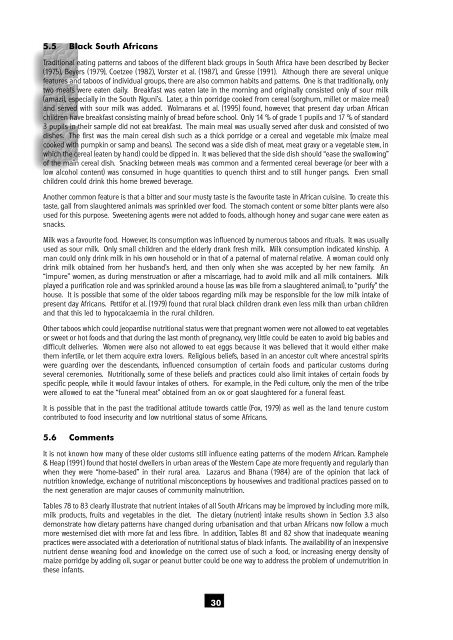the nutritional status of - Health Systems Trust
the nutritional status of - Health Systems Trust
the nutritional status of - Health Systems Trust
You also want an ePaper? Increase the reach of your titles
YUMPU automatically turns print PDFs into web optimized ePapers that Google loves.
5.5 Black South Africans<br />
Traditional eating patterns and taboos <strong>of</strong> <strong>the</strong> different black groups in South Africa have been described by Becker<br />
(1975), Beyers (1979), Coetzee (1982), Vorster et al. (1987), and Gresse (1991). Although <strong>the</strong>re are several unique<br />
features and taboos <strong>of</strong> individual groups, <strong>the</strong>re are also common habits and patterns. One is that traditionally, only<br />
two meals were eaten daily. Breakfast was eaten late in <strong>the</strong> morning and originally consisted only <strong>of</strong> sour milk<br />
(amazi), especially in <strong>the</strong> South Nguni’s. Later, a thin porridge cooked from cereal (sorghum, millet or maize meal)<br />
and served with sour milk was added. Wolmarans et al. (1995) found, however, that present day urban African<br />
children have breakfast consisting mainly <strong>of</strong> bread before school. Only 14 % <strong>of</strong> grade 1 pupils and 17 % <strong>of</strong> standard<br />
3 pupils in <strong>the</strong>ir sample did not eat breakfast. The main meal was usually served after dusk and consisted <strong>of</strong> two<br />
dishes. The first was <strong>the</strong> main cereal dish such as a thick porridge or a cereal and vegetable mix (maize meal<br />
cooked with pumpkin or samp and beans). The second was a side dish <strong>of</strong> meat, meat gravy or a vegetable stew, in<br />
which <strong>the</strong> cereal (eaten by hand) could be dipped in. It was believed that <strong>the</strong> side dish should “ease <strong>the</strong> swallowing”<br />
<strong>of</strong> <strong>the</strong> main cereal dish. Snacking between meals was common and a fermented cereal beverage (or beer with a<br />
low alcohol content) was consumed in huge quantities to quench thirst and to still hunger pangs. Even small<br />
children could drink this home brewed beverage.<br />
Ano<strong>the</strong>r common feature is that a bitter and sour musty taste is <strong>the</strong> favourite taste in African cuisine. To create this<br />
taste, gall from slaughtered animals was sprinkled over food. The stomach content or some bitter plants were also<br />
used for this purpose. Sweetening agents were not added to foods, although honey and sugar cane were eaten as<br />
snacks.<br />
Milk was a favourite food. However, its consumption was influenced by numerous taboos and rituals. It was usually<br />
used as sour milk. Only small children and <strong>the</strong> elderly drank fresh milk. Milk consumption indicated kinship. A<br />
man could only drink milk in his own household or in that <strong>of</strong> a paternal <strong>of</strong> maternal relative. A woman could only<br />
drink milk obtained from her husband’s herd, and <strong>the</strong>n only when she was accepted by her new family. An<br />
“impure” women, as during menstruation or after a miscarriage, had to avoid milk and all milk containers. Milk<br />
played a purification role and was sprinkled around a house (as was bile from a slaughtered animal), to “purify” <strong>the</strong><br />
house. It is possible that some <strong>of</strong> <strong>the</strong> older taboos regarding milk may be responsible for <strong>the</strong> low milk intake <strong>of</strong><br />
present day Africans. Pettifor et al. (1979) found that rural black children drank even less milk than urban children<br />
and that this led to hypocalcaemia in <strong>the</strong> rural children.<br />
O<strong>the</strong>r taboos which could jeopardise <strong>nutritional</strong> <strong>status</strong> were that pregnant women were not allowed to eat vegetables<br />
or sweet or hot foods and that during <strong>the</strong> last month <strong>of</strong> pregnancy, very little could be eaten to avoid big babies and<br />
difficult deliveries. Women were also not allowed to eat eggs because it was believed that it would ei<strong>the</strong>r make<br />
<strong>the</strong>m infertile, or let <strong>the</strong>m acquire extra lovers. Religious beliefs, based in an ancestor cult where ancestral spirits<br />
were guarding over <strong>the</strong> descendants, influenced consumption <strong>of</strong> certain foods and particular customs during<br />
several ceremonies. Nutritionally, some <strong>of</strong> <strong>the</strong>se beliefs and practices could also limit intakes <strong>of</strong> certain foods by<br />
specific people, while it would favour intakes <strong>of</strong> o<strong>the</strong>rs. For example, in <strong>the</strong> Pedi culture, only <strong>the</strong> men <strong>of</strong> <strong>the</strong> tribe<br />
were allowed to eat <strong>the</strong> “funeral meat” obtained from an ox or goat slaughtered for a funeral feast.<br />
It is possible that in <strong>the</strong> past <strong>the</strong> traditional attitude towards cattle (Fox, 1979) as well as <strong>the</strong> land tenure custom<br />
contributed to food insecurity and low <strong>nutritional</strong> <strong>status</strong> <strong>of</strong> some Africans.<br />
5.6 Comments<br />
It is not known how many <strong>of</strong> <strong>the</strong>se older customs still influence eating patterns <strong>of</strong> <strong>the</strong> modern African. Ramphele<br />
& Heap (1991) found that hostel dwellers in urban areas <strong>of</strong> <strong>the</strong> Western Cape ate more frequently and regularly than<br />
when <strong>the</strong>y were “home-based” in <strong>the</strong>ir rural area. Lazarus and Bhana (1984) are <strong>of</strong> <strong>the</strong> opinion that lack <strong>of</strong><br />
nutrition knowledge, exchange <strong>of</strong> <strong>nutritional</strong> misconceptions by housewives and traditional practices passed on to<br />
<strong>the</strong> next generation are major causes <strong>of</strong> community malnutrition.<br />
Tables 78 to 83 clearly illustrate that nutrient intakes <strong>of</strong> all South Africans may be improved by including more milk,<br />
milk products, fruits and vegetables in <strong>the</strong> diet. The dietary (nutrient) intake results shown in Section 3.3 also<br />
demonstrate how dietary patterns have changed during urbanisation and that urban Africans now follow a much<br />
more westernised diet with more fat and less fibre. In addition, Tables 81 and 82 show that inadequate weaning<br />
practices were associated with a deterioration <strong>of</strong> <strong>nutritional</strong> <strong>status</strong> <strong>of</strong> black infants. The availability <strong>of</strong> an inexpensive<br />
nutrient dense weaning food and knowledge on <strong>the</strong> correct use <strong>of</strong> such a food, or increasing energy density <strong>of</strong><br />
maize porridge by adding oil, sugar or peanut butter could be one way to address <strong>the</strong> problem <strong>of</strong> undernutrition in<br />
<strong>the</strong>se infants.<br />
30
















